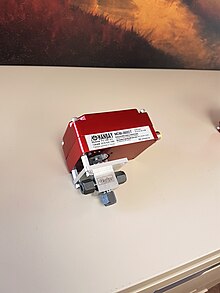BALL VALVE | MANUFACTURER | SUPPLIER | DEALER | PUNE | MAHARASHTRA | INDIA +91-9881236139
BALL VALVES
Ball valves are durable, performing well after many cycles, and reliable, closing securely even after long periods of disuse. These qualities make them an excellent choice for shutoff and control applications, where they are often preferred to gates and globe valves, but they lack their fine control in throttling applications.
The ball valve's ease of operation, repair, and versatility lend it to extensive industrial use, supporting pressures up to 1000 bar and temperatures up to 752 °F (400 °C), depending on design and materials used. Sizes typically range from 0.2 to 48 inches (0.5 cm to 121 cm). Valve bodies are made of metal, plastic, or metal with a ceramic; floating balls are often chrome plated for durability. One disadvantage of a ball valve is that they trap water in the center cavity while in the closed position. In the event of a freeze, the sides can crack due to expansion of ice forming. Some means of insulation or heat tape in this situation will usually prevent damage. Another option for cold climates is the "freeze tolerant ball valve". This style of ball valve incorporates a freeze plug in the side so in the event of a freeze up, the freeze plug ruptures (acts as a sacrificial disk), thus making for an easy repair. Now instead of replacing the whole valve, just screw in a new freeze plug.
In the case that a ball valve is used for cryogenics or product that may expand inside of the ball, there is a vent drilled into the upstream side of the valve. This is referred to as a vented ball. Safety is the number one concern when engineers specify a vented ball.
A ball valve should not be confused with a "ball-check valve", a type of check valve that uses a solid ball to prevent undesired backflow.
Other types of quarter-turn valves include the butterfly valve and plug valve and freeze proof ball valve.

Automated 3 way ball valve.
Contents
- 1 Types
- 1.1 Full port
- 1.2 Reduced port or reduced bore
- 1.3 V port
- 1.4 Cavity filler
- 1.5 Trunnion
- 1.6 Multiport
- 2 Materials of construction
- 3 See also
- 4 References
Types
There are five general body styles of ball valves: single body, three-piece body, split body, top entry, and welded. The difference is based on how the pieces of the valve—especially the casing that contains the ball itself—are manufactured and assembled. The valve operation is the same in each case.In addition, there are different styles related to the bore of the ball mechanism itself. And depends on the working pressure, the ball valves are divided as low pressure ball valves and high pressure ball valves. In most industries, the ball valves with working pressure higher than 3000 psi are considered as high pressure ball valves. Usually the max. working pressure for the high pressure ball valves[3] is 7500 psi, and depends on the structure, sizes and sealing materials, the max. working pressure of high pressure ball valves can be up to 15000 psi. High pressure ball valves are mostly used in applications under high pressure such as hydraulic systems, so they are known as hydraulic ball valves also.
Ball valves in sizes up to 2 inch generally come in single piece, two or three piece designs. One piece ball valves are almost always reduced bore, are relatively inexpensive and generally are throw-away. Two piece ball valves are generally slightly reduced (or standard) bore, they can be either throw-away or repairable. The 3 piece design allows for the center part of the valve containing the ball, stem & seats to be easily removed from the pipeline. This facilitates efficient cleaning of deposited sediments, replacement of seats and gland packings, polishing out of small scratches on the ball, all this without removing the pipes from the valve body. The design concept of a three piece valve is for it to be repairable.
Full port
A full port or more commonly known full bore ball valve has an over-sized ball so that the hole in the ball is the same size as the pipeline resulting in lower friction loss. Flow is unrestricted but the valve is larger and more expensive so this is only used where free flow is required, for example in pipelines which require pigging.Reduced port or reduced bore
In Reduced port (more commonly known as reduced bore) ball valves, flow through the valve is one pipe size smaller than the valve's pipe size resulting in flow area being smaller than pipe. As the flow discharge remains constant and is equal to area of flow (A) times velocity (V), the velocity increases with reduced area of flow.V port
A V port ball valve has either a 'v' shaped ball or a 'v' shaped seat. This allows for linear and even equal percentage flow characteristics. When the valve is in the closed position and opening is commenced the small end of the 'v' is opened first allowing stable flow control during this stage. This type of design requires a generally more robust construction due to higher velocities of the fluids, which might damage a standard valve. These can be referred to as a type of control valve but are typically not as accurate as a balancing valve, needle valve, globe valve, or pressure regulating valve.Cavity filler
Many industries encounter problem with residues in the ball valve. Where the fluid is meant for human consumption, residues may also be health hazard, and when where the fluid changes from time to time contamination of one fluid with another may occur. Residues arise because in the half open position of the ball valve a gap is created between the ball bore and the body in which fluid can be trapped. To avoid the fluid getting into this cavity, the cavity has to be plugged, which can be done by extending the seats in such a manner that it is always in contact with the ball. This type of ball valve is known as Cavity Filler Ball Valve.There are a few types of ball valves related to the attachment and lateral movement of the ball:
Trunnion
A trunnion ball valve has additional mechanical anchoring of the ball at the top and the bottom, suitable for larger and higher pressure valves (say, above 10 cm and 40 bars).A floating ball valve is one where the ball is not held in place by a trunnion. In normal operation, this will cause the ball to float downstream slightly. This causes the seating mechanism to compress under the ball pressing against it. Furthermore, in some types, in the event of some force causing the seat mechanism to dissipate (such as extreme heat from fire outside the valve), the ball will float all the way to metal body which is designed to seal against the ball providing a somewhat failsafe design.
Manually operated ball valves can be closed quickly and thus there is a danger of water hammer. Some ball valves are equipped with an actuator that may be pneumatically, hydraulically or motor operated. These valves can be used either for on/off or flow control. A pneumatic flow control valve is also equipped with a positioner which transforms the control signal into actuator position and valve opening accordingly.
Multiport

Schematic 3 way ball valve: L-shaped ball right, T-shaped left
- Three- and four-way have an L- or T-shaped hole through the middle. The different combinations of flow are shown in the figure. It is easy to see that a T valve can connect any pair of ports, or all three, together, but the 45 degree position which might disconnect all three leaves no margin for error. The L valve can connect the center port to either side port, or disconnect all three, but it cannot connect the side ports together.
- Multi-port ball valves with 4 ways, or more, are also commercially available, the inlet way often being orthogonal to the plane of the outlets. For special applications, such as driving air-powered motors from forward to reverse, the operation is performed by rotating a single lever four-way valve. The 4-way ball valve has two L-shaped ports in the ball that do not interconnect, sometimes referred to as an "×" port.
Materials of construction

Balls for alloy ball valves

Ball for a titanium ball valve
- Stainless steel
- Brass
- Bronze
- Chrome
- Titanium
- PVC
- CPVC
- PFA-lined
- And many more
- TFM
- Delrin
- Reinforced Teflon (RTFE)
- Kel F (PCTFE)
- Metal
- Nylon
- PEEK
- 50/50
- Virgin Teflon (TFE)
- UHMW Polyethylene (UHMWPE)
- Graphoil
- Viton
CONTACT US
Email Id- pramod@parthvalve.com/sales3@parthvalve.com
Call us - +91-9881236139/7722005619




Comments